¶ Definition
The term telepresence is made up of the prefix « tele », coming from the Greek term tễle which means « far » or « at a distance », and the word « presence »; telepresence therefore comes down to a feeling of presence, experienced by a sensitive body, with another place or body, despite a physical distance.
Telepresence refers to several techniques that allow a person to feel like they are present or have an effect in a place other than their actual location. It requires that the senses of the user, or users, be subjected to stimuli that give the impression of being at a distant site. In addition to this, the user may have the ability to act on this remote site. In this case, the position of the user as well as his movements, actions, or words can be perceived, transmitted and duplicated towards the desired destination to put this effect into action. Because of this, information can travel back and forth between the user and the remote location.
WIKIPÉDIA
To apply this principle, telepresence generally depends on a technical device offering:
- capturing perceptible phenomena (sound, image, gesture, etc.);
- a means of transmission allowing the phenomena captured to instantaneously travel the distance between their place of origin and a destination;
- the perceptible reproduction of the phenomena captured (sound, image, gesture, etc.).
Therefore, telepresence occurs through the creation of a media space for meeting and virtual exchange, made possible by a technical device capable of capturing, transmitting and broadcasting in real time and size stimuli - especially audiovisual - between several spaces or physically distant individuals.
¶ Theory and philosophy
¶ Immersion and presence
The sensation of presence is often made possible by the immersive qualities of a technical device capable of reproducing certain sensory stimuli.
However, it is important to clearly distinguish the sensation of presence from immersion through the senses, because these phenomena, although favorable, are nevertheless contingent.
¶ Immersion
A thing is said to be immersed in a fluid as opposed to a situation
tacitly considered more common in which the thing would not be immersed. Immersion therefore occurs relative to a habitual configuration, just as representation occurs relative to presentation.
Bruno TRENTINI (2014)
If originally the term immersion designates the passage of a body from a gaseous medium (air) to a liquid medium (water), its derived meaning is generally transposed to a subjective point of view, where a sensitive individual, already present in an environment or a configuration that he perceives as being usual, passes to an environment or a configuration that he perceives as being unusual.
An individual present in a context that he perceives as unusual is therefore led to adapt to it by reconfiguring his way of perceiving and interacting with this environment.
From a subjective point of view, such a reconfiguration involves contact with the senses which allows the individual to take note and become aware of the familiarity of a situation or the environment in which he finds himself. By habituation and by dint of repetitions, a new convention is formed, a new code by which the perception of stimuli or sensations is substituted by labels. It is then that the same stimulus can be perceived differently, depending on its context of appearance, and identified accordingly, according to the established code.
Thus, an experience of immersion is an aesthetic experience insofar as the meeting of two different worlds, different in relation to the means of perception involved, induces a reflective judgment allowing the subject to become aware of the flexibility of his perception. .
Bruno TRENTINI (2014)
There are two essential factors that contribute to creating an immersive experience:
- a sensitive and conscious change of configuration, from the usual to the unusual, to which…
- the experimental subject responds according to his will to adapt. Immersion then manifests itself as an adhesion to this change of configuration.
Immersion is therefore the ability to access a proposed universe and to make this universe accessible to oneself.
¶ Presence
The term « presence », on the other hand, is frequently used to designate a cognitive effect produced by a particular technology (Auvray et al., 2005 and Lombard and Ditton, 1997) which makes it possible to envelop one or more senses in an individual.
Thanks to a technological device, a subject can experience a feeling of presence in a proposed environment, insofar as the latter perceives it as being different from the one in which he is currently present.
But beware, physical immersion, by the greater or lesser envelopment of the senses, does not necessarily lead to a feeling of presence as a “perceptual illusion of non-mediation” (Lombard and Ditton, 1997). The presence effect is rather a psychological consequence that can, in particular, be induced by stimulation of the senses, through specific sensory conditions, i.e. immersion.
Immersion is therefore above all a current phenomenon - linked to the sensory conditions of an immediate environment and their apprehension by the senses - where "the activation of the subject’s attention is produced directly by his environment” (Guelton, 2014) and where perception and action are closely correlated.
This phenomenon must be distinguished from presence, the psychological effect specific to the consciousness of individuals to feel present in a virtual environment – also perceived as real –, as an illusion of non-mediation made possible by through a technical device (Slater and Wilbur, 1997).
These two phenomena can mutually reinforce each other, but are not necessary for each other: one can feel present in a virtual environment or with distant people, without the sensory conditions being perfectly transparent (realistic) for as much; conversely, it is not because a technical device makes it possible to simulate certain stimuli in a transparent and realistic way that the subject will necessarily feel present in a virtual “elsewhere”.
In a context of virtual exchanges or meetings, made possible by technical means, the sensation of presence implies that there is first a detachment, a gap, a distance, a mediation, a simulation, a substitution of the body of individuals between their immediate physical space and the non-immediate one (mediate) where other individuals would be located.
Otherwise the presence would no longer be just a sensation, but would be a fact:
- Current presence as a fact: a person X is currently in the presence of a person Y within the same physical space Z;
- Virtual presence as sensation: a person X - physically present in a place A - feels virtually in the presence of a person Y - physically present in a place B - through a media space Z.
¶ Technical device
Telepresence occurs through the creation of a media space for meeting and virtual exchange, made possible by a technical device capable of capturing, transmitting and broadcasting in real time and size stimuli - especially audiovisual - between several spaces or individuals physically distant.
Today, telepresence devices connect distant places via the Internet and promote meetings and interactions in real time between them. Through an immersive installation, you can give the feeling that one place extends into another. Remote groups can see each other, talk to each other, interact and collaborate remotely, as if they were in the same space. Thus, telepresence is essentially based on the bidirectional and simultaneous transmission of audiovisual streams, in time and in real size.
¶ Stage telepresence
Applied to the performing arts, a scenic telepresence device offers the possibility of creating a work distributed between different venues where artists and distant audiences can meet.
Scenic telepresence differs from telepresence by videoconference - a more common application in daily life - by the immersivity of the technical device and by the fact that it is no longer content to simply share sound and image in close-up (chest) of a single individual per place, but rather that of one or more individuals in medium shot, or even part of a scenic space, and display it in real size (1:1), that is to say according to human scale proportions.
To do this, such a device should allow:
- To connect several devices or equipment for capturing and broadcasting professional quality multimedia;
- Instantly, simultaneously and individually share multiple streams with one or more other similar devices;
- Receive, retransmit and broadcast, instantly, simultaneously and individually several streams from one or more other similar devices;
- Reproduce audiovisual stimuli in a realistic or immersive way so as to promote the feeling of presence, in particular by:
- One or more video displays of sufficient size to maintain a 1:1 proportion of the space or subjects represented;
- The calibration of the capture angle and the video projection, in order to reproduce communication by the gaze between individuals;
- The spatialization of audio sources according to the visual location of the subject or the emitting object;
- The prevention or reduction of any technical issue that could break the immersion of the spectators or harm the interaction of the participating subjects.
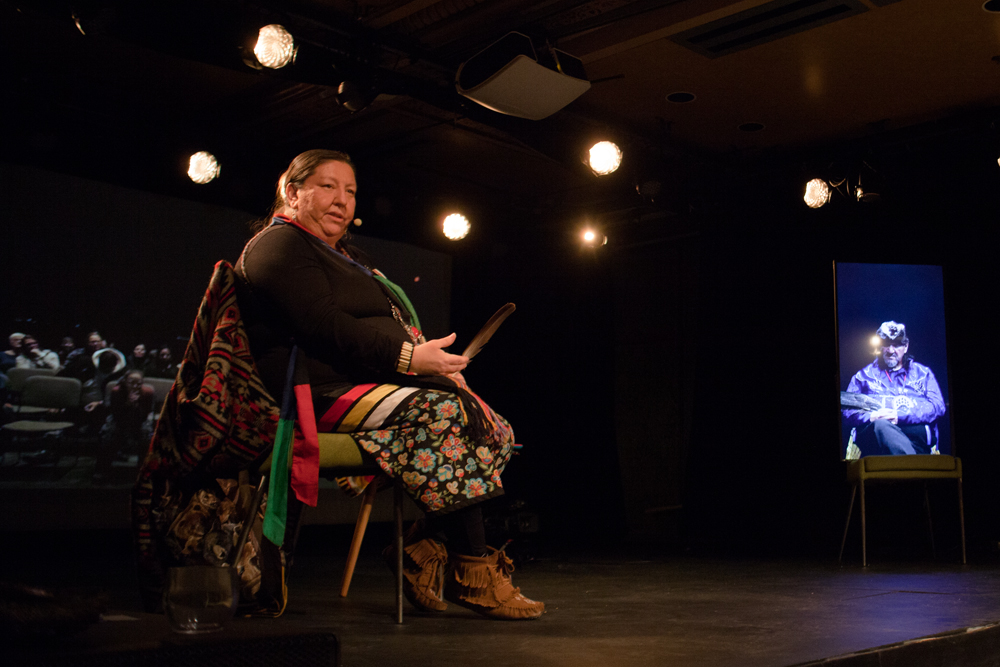
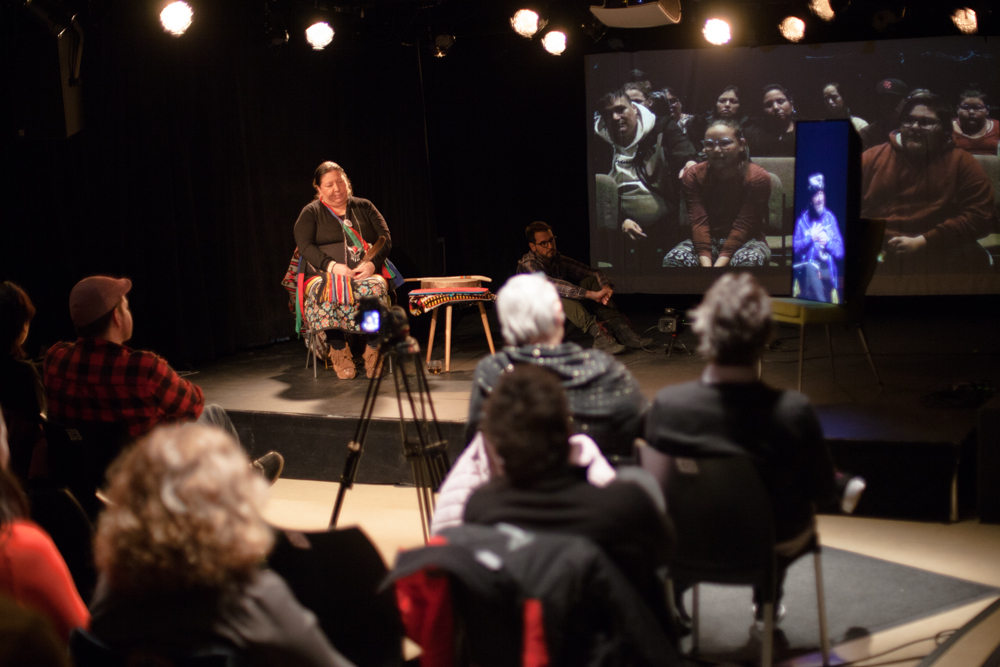
¶ Telepresence at the Society for Technological Arts (SAT)

Founded in 1996, the Society for Arts and Technology [SAT] is a non-profit organization recognized internationally for its active and pioneering role in the development of immersive technologies, virtual reality and the creative use of very high speed networks.
¶ See you… on the public benches (1999)
Telepresence stations connect the space in front of the entrance to the Musée d’arts contemporain de Montréal (MAC) with Place d’Youville in Quebec City. This concept by Luc Courschesne and Monique Savoie allows passers-by in two cities to exchange messages.
¶ Métalab
The Metalab is the research and development laboratory of the SAT. Formed in 2002, its mission is to stimulate the emergence of innovative immersive experiences and make their design accessible to artists and creators through an ecosystem of open source software.
¶ Membres actuels
- Nicolas Bouillot (co-direction)
- Emmanuel Durand (co-direction)
- Michal Seta
- Thomas Piquet
- Édith Viau
- Christian Frisson
¶ Breaking the Ice (2010)
As part of CODE, the digital edition of the Vancouver 2010 Cultural Olympiad, the Society for Arts and Technology [SAT] presented Breaking the Ice, an audio-tactilo-visual telepresence installation inviting passers-by to the Grande Bibliothèque (Montreal) to interact with the people present at the Vancouver 2010 Winter Olympics.
The implementation of these unique interactive communication bases is the result of a collaboration between researchers and designers from the SAT (Metalab) and the artist Paul Warne. Warne had been commissioned to design an original interface allowing the user to deconstruct a human face using a virtual puzzle.
The principle was to stand in front of a virtual « mirror » and « break the ice » to reconstruct and discover the face of the person behind - in fact at the other end of the country (Vancouver) - and to be able to exchange with them .
This state-of-the-art technology is an integration of Scenic (protoype) and SPIN software, two programs developed by the Metalab research project, and uses very high speed connections available via efficient fiber optic networks. .
¶ Valorization of research
Founded in 2018, the Research Valorization Department mobilizes free technologies from Métalab, the research and development laboratory of the Société des Arts Technologiques [SAT], to develop projects with a social or artistic scope with various partners. Located at the crossroads of applied research and commercial pre-production, the department emphasizes the use and development of free software and a living laboratory methodology that places great emphasis on end users and experimentation.
¶ Membres actuels
- Francis Lecavalier (co-direction)
- Claire Paillon (co-direction)
- Valentin Laurent
- Matthew Hills
- David Ledoux
- Olivier Gauthier
- Guillaume Riou
- Rachel Germain
¶ Bibliolab

Bibliolab is in a way a simplified version and precursor to the telepresence device Scenic in its current form:
- Designed for educational application at school level (primary and secondary);
- Networking school libraries with the rooms of the Open Scenes network;
- Promote meetings and exchanges between users of different places.
The Bibliolab device is symmetrical and can accommodate two activity formats:
- “Formal” activities that highlight the facilitators and their content and are particularly suitable for conference and training activities;
- “Participatory” activities that place participants face to face to facilitate interactions and support discussion and game activities.
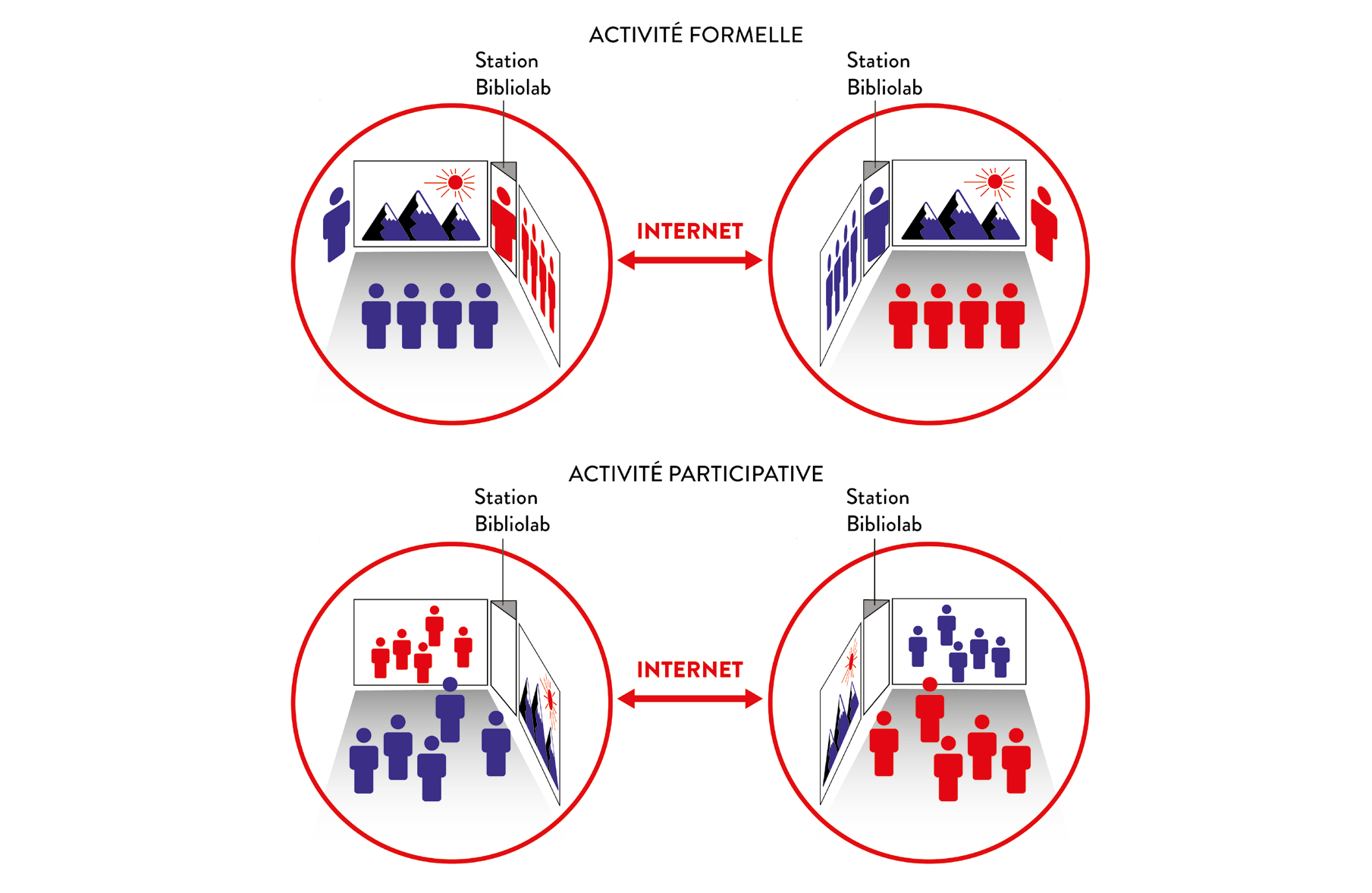
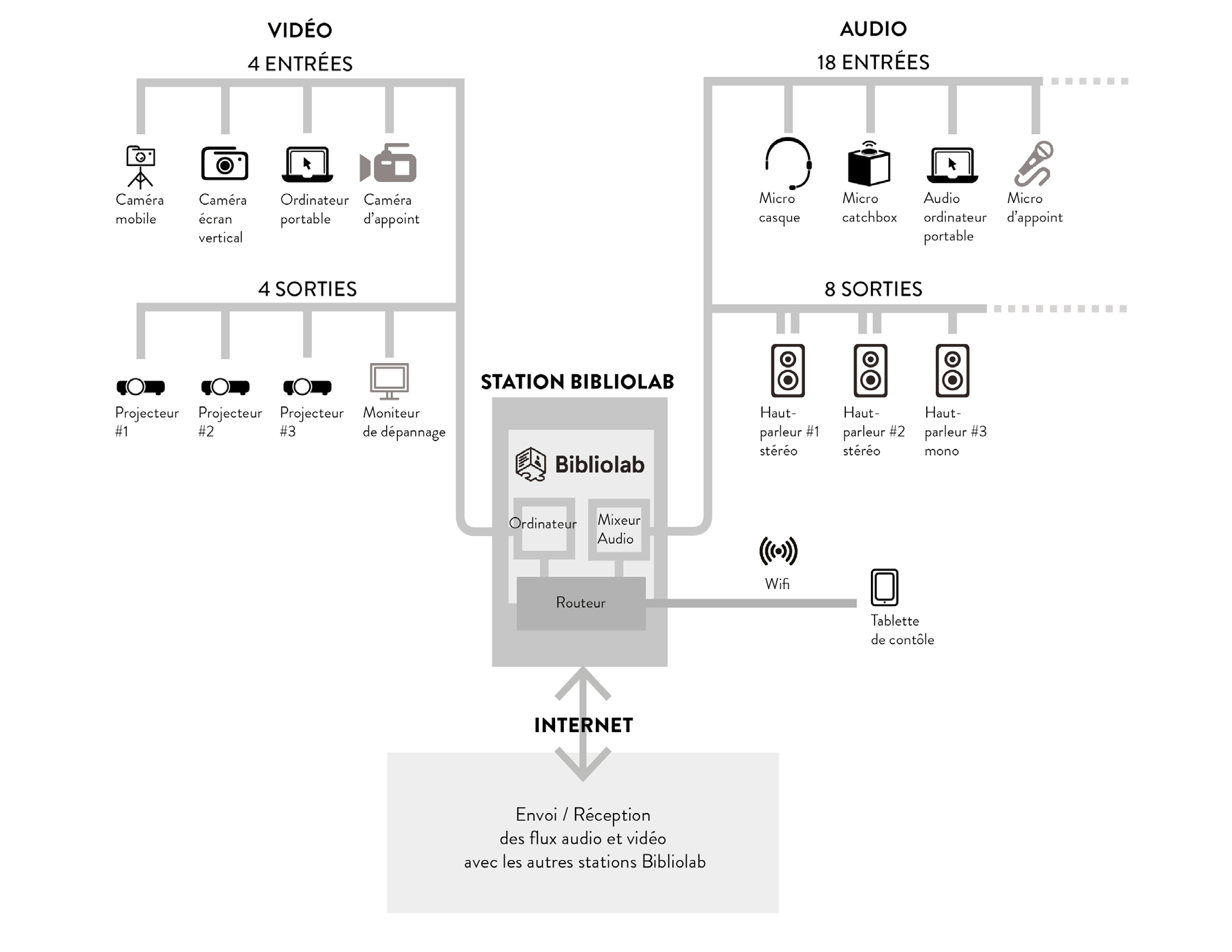
¶ Scenic

¶ La station Scenic (Pro)
La station Scenic permet de connecter des équipements multimédia de qualité professionnelle, tels que des projecteurs et écrans vidéo, des micros, une console de son et des haut-parleurs amplifiés, des contrôleurs par données MIDI ou OSC, pour capter, reproduire et diffuser des flux audiovisuels, selon une scénographie adaptée.
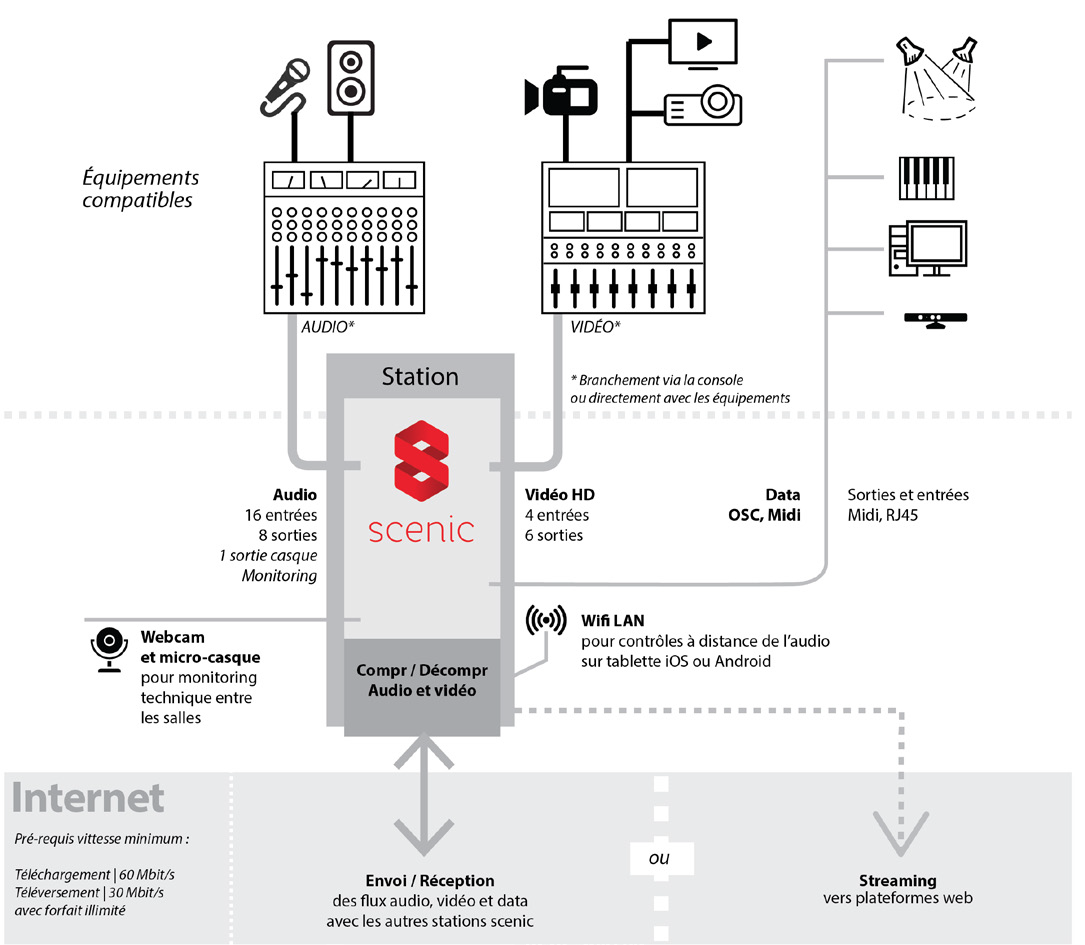
¶ The scenic app
- In 2009, the SAT launched its Scenic transmission software, with a show between Gaspé and Montreal that brought together members of the National Parks group;
The Scenic application allows the transmission and reception in real time and in high definition of audio and video streams, as well as MIDI and OSC data. With a reliable and high-speed internet connection, geographically distant spaces can thus connect and produce scenic events in telepresence.
¶ Scenic 3 (2019-2020)

Scenic 3 Interface Overview
¶ Scenic 4 (depuis 2021)
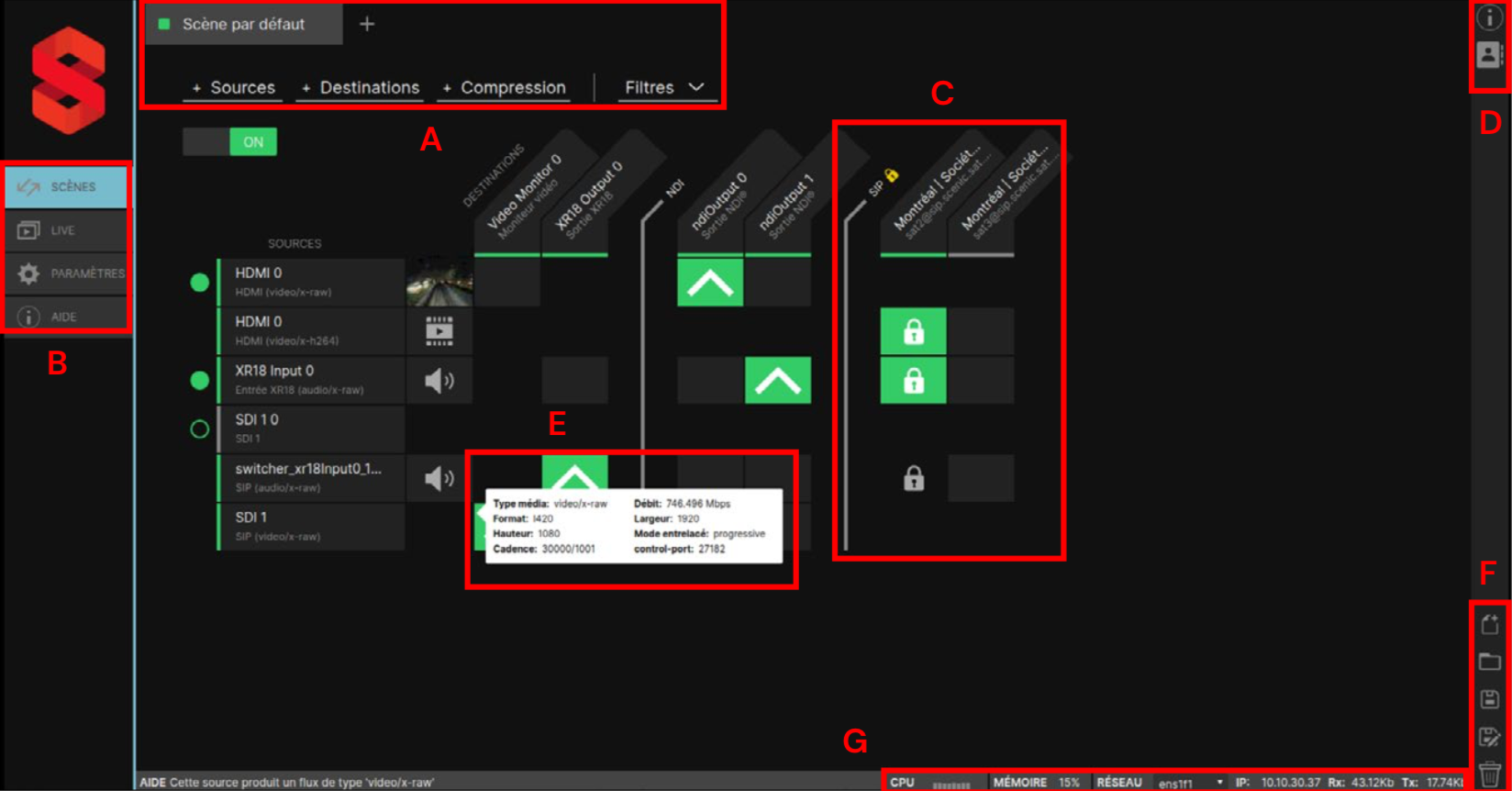
*Scenic 4 Interface Overview *
¶ Scènes Ouvertes

Launched in September 2017, the Scènes Ouvertes network now includes 23 performance halls and cultural mediation spaces, spread across Quebec. Initiated by the Society for Arts and Technology [SAT], the network is part of the Quebec Digital Cultural Plan of the Ministry of Culture and Communications (MCC).
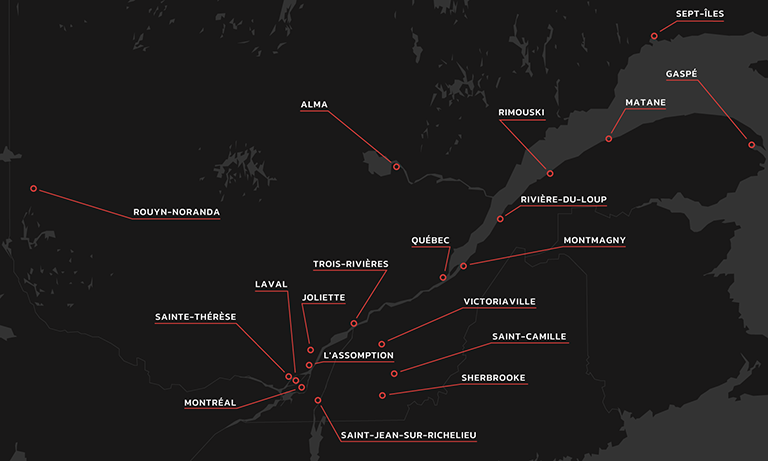
Each space member of the Scènes Ouvertes network has a Scenic station. These mobile devices are notably equipped with a computer system using the Scenic application, developed by the SAT research promotion department.
Unlike webcasting, Scenic technology allows spaces equipped with this station to design, create, collaborate and broadcast activities or events via telepresence, together with other network member spaces.
In addition to the Scenic station, the members of the Scènes Ouvertes network benefit from an offer of advisory assistance services for the support of scenic telepresence projects, technical support as well as training for the autonomous operation of the Scenic stations.
¶ Espaces membres actuels
| City | Organization |
|---|---|
| Alma | Ville d’Alma Spectacles |
| Gaspé | C.D. Spectacles inc. |
| Joliette | Centre culturel de Joliette |
| L’Assomption | Diffusion Hector-Charland |
| Laval | Laval Co-Motion - Corp. Salle André Mathieu |
| Matane | Kaméléart Matane inc. |
| Montmagny | Les Arts de la scène de Montmagny |
| Montréal | Place Des Arts |
| Montréal | Monument National |
| Montréal | Société des Arts Technologiques (SAT) |
| Montréal | Corporation du Théâtre Outremont |
| Montréal | ToHu, Cité des arts et du Cirque |
| Québec | Musée de la Civilisation du Québec (MCQ) |
| Rimouski | Coopérative de solidarité Paradis |
| Rivière-du-Loup | Rivière-du-Loup en spectacles |
| Rouyn-Noranda | Petit Théâtre du Vieux Noranda |
| Saint-Camille | Le p’tit bonheur de Saint-Camille |
| Sainte-Thérèse | Odyscène inc. |
| Sept-Îles | Sept-iles Salle Jean-Marc-Dion |
| Sherbrooke | Centre culturel de l’Université de Sherbrooke |
| St-Jean-sur-Richelieu | Société pour la promotion d’événements culturels du Haut-Richelieu |
| Trois-Rivières | Espace Pauline-Julien (Culture Trois-Rivières) |
| Victoriaville | Diffusion Momentum / Le Carré 150, espace culturel de Victoriaville |
¶ Bancs d’essai
From January 2019, thanks to the support of the Ministry of Culture and Communications, the SAT is setting up a test bench program in order to develop the expertise in scenic telepresence of the members of the Open Scenes network. They then benefit from financial support and support from the SAT to develop content tailored for telepresence. Joint residencies between the spaces of the network are set up to create works, performances and cultural mediation activities which are presented to different audiences.